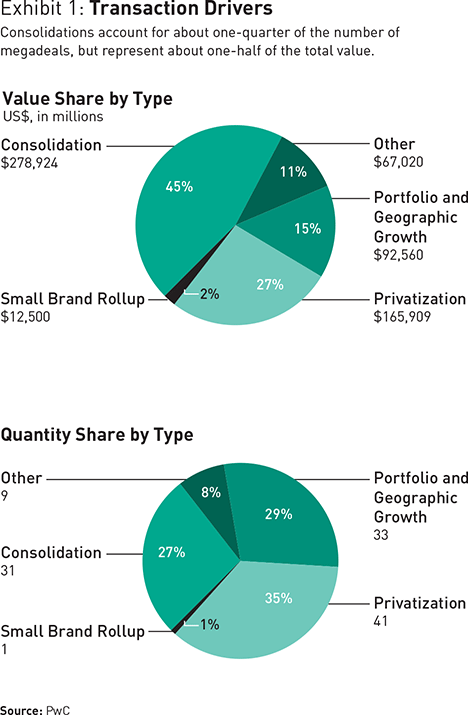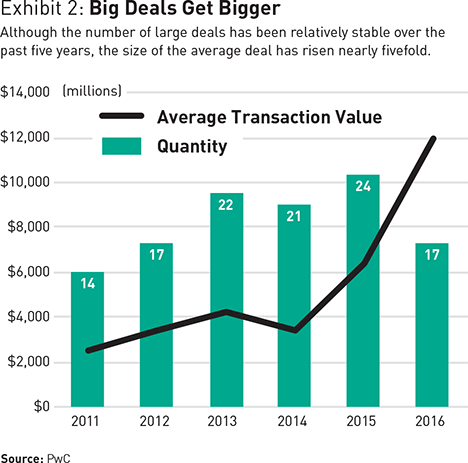Megadeals in consumer packaged goods
How supersized deals are helping the sector respond to challenges.
Cigarette sales in the U.S. are shrinking annually, and in 2014, Reynolds American Inc. (RAI) sought a merger that could bolster its cigarette business, reduce costs through simplified operations and increased scale, and enhance shareholder value. RAI found a potential mate in Lorillard, a rival with its own stable of popular cigarette brands, including the top-selling menthol brand, Newport. To address regulatory concerns about a potential cigarette duopoly between Altria, owner of Marlboro, and RAI in the U.S., RAI divested its Winston and Kool brands as well as all other Lorillard operations to the U.S. arm of Imperial Tobacco, thus establishing a strong third competitor in the market.
The carefully constructed Reynolds–Lorillard merger and asset sale, which closed in June 2015, was a big deal — a very big deal. At a total value of US$25 billion, it was one of the largest deals ever in the consumer packaged goods (CPG) sector, behind only the $26 billion 2012 Kraft Foods spinoff. Those two transactions, however, were soon dwarfed by the Kraft Food Group–H.J. Heinz consolidation in July 2015, at $46 billion, and then by the $101 billion SABMiller–Anheuser-Busch InBev merger in October 2016.
In the boardroom and on Wall Street, a new catchphrase is ringing out: Supersize me! This dramatic rise in deal value is rapidly reshaping the CPG landscape. In response to sluggish organic growth and activist investor pressure to enhance value, many of the biggest companies in the sector are scrambling to find ways of optimizing portfolios and cutting costs. A review by PwC of the 115 CPG megadeals (those valued at $3 billion or more) that took place between January 2011 and October 14, 2016, found that of the 20 biggest, 16 exceeded $10 billion; six exceeded $20 billion. Between January 2014 and October 2016, the average megadeal size more than tripled, from about $4 billion to more than $14 billion. This dramatic rise in deal value comes as the number of megadeals remains fairly constant year to year, as Exhibit 1 shows.
Trend Drivers
What’s driving these souped-up deals, and what does it mean to companies in the sector? CPG companies have faced particularly acute and long-standing business challenges, making them appealing targets for activist investors and merger agendas. Overall, the industry has experienced only GDP-level growth and nearly flat margins for almost a decade. This has drawn the attention of industry disruptors, which come with a much more aggressive cost thesis to drive value.
The drag on revenue growth and operating margins can be linked to some externalities, like the run-up in commodity costs before the 2008 economic meltdown, but the bigger issue for the industry has been the breakdown in major components of the traditional large CPG model. This includes the fragmentation of consumer tastes, the proliferation of alternative channels (e.g., Whole Foods, Trader Joe’s), the rise of digital channels as a way of reaching consumers outside traditional mass media routes, and the disaggregation of value chains enabling small players to achieve big-player scale through outsourcing. As a result, in many categories, small brands, once a minor annoyance to the majors, have gained significant traction and taken a disproportionate share of growth. Big, well-known brands and the companies that owned them have seen their market dominance erode as their businesses have seemingly been beset on all sides.
Large, established CPG companies have yet to find an effective answer to these challenges beyond cutting costs. In the food category, for instance, 80 percent of gross margin improvements from 2009 to 2014 came from cuts in sales, general, and administrative (SG&A) expenses.
Consolidation and Privatization
Given the trends, it’s not surprising that the overwhelming proportion of the supersized deals we have seen recently are being driven by transactions that can set the stage for aggressive cost reduction. Nine of the 10 highest-priced recent megadeals were one of two transaction types: consolidation or privatization. These two leading transactions accounted for three-fourths of all megadeal value (45 percent and 27 percent by deal value, respectively) during the sample period. Other transaction types, such as portfolio growth, geographic growth, and small brand rollup, were also part of the mix. But those types of deals typically came in at lower absolute values.
Although there have been fewer consolidations than privatizations, consolidations carried higher price tags and were more responsible for the rise in deal value (see Exhibit 2). Consolidations accounted for 45 percent of all megadeals by value since 2011, including three of the four biggest megadeals in the sample: SABMiller–Anheuser-Busch, Kraft Foods–H.J. Heinz, and RAI–Lorillard. Those three companies were in the industry categories that experienced the most consolidations: beer, food, and tobacco.
Among other megadeal consolidations of 2016: Haier bought the GE Appliances business for $5.6 billion in May; Coty Inc. bought the Procter & Gamble beauty business line for $14.9 billion in October; and kitchen appliance company Newell (known for its Mr. Coffee machines) paid $15.4 billion in April for housewares conglomerate Jarden.
Deals that appear favorable today might lead nowhere after months — or even years — of consideration.
Privatization has been behind the largest number of recent megadeals, accounting for about one-third of transactions and about one-third of deal value. Privatizations can lead to many of the same types of cost cuts that are evident in consolidations. Indeed, some privatizations involve consolidating a public company into an existing privately held one.
Consolidation and privatization have been leading the way into higher-priced deals, but other transaction types have not been immune to inflation in deal valuation. Danone’s plan announced in July 2016 to acquire WhiteWave Foods is a small brand rollup that rings in at $12.5 billion. In January 2016, Japan Tobacco International spent $5 billion — a whopping 250 times earnings before interest and taxes in international markets — on Reynolds American’s Natural American Spirit brand in order to gain a greater position in superpremium brands with a natural heritage and to use the Japan Tobacco International footprint to take the brand global.
Aligning for Megamerger Opportunities
The increasing size of deals means that even the biggest CPG companies may now find themselves takeover targets. To survive and succeed in this new era of megadeals, leaders must develop a clear strategy that allows them to respond to current expectations for growth and profits.
Focus on capabilities. How to reinvigorate top-line growth is the major unsolved problem for the industry at the moment. Even while they have established new industry benchmarks, investors from outside the industry have driven most of their value via consolidation and cost reduction. Other CPGs do have the opportunity to find a different balance of cost reduction plus growth, but the performance marker is clear. Our long-term research on capabilities-driven strategy underscores the critical linkage of portfolio and resource allocation against a distinct way to play backed by strong capabilities. This also becomes a strong basis for identifying gaps in the business that could be addressed through M&A, including megadeals.
Pursue cost cutting. Cost reduction remains an important element in CPG strategies. There is still room for more consolidation within the industry, involving not just brands and businesses but different parts of the value chain such as manufacturing. In addition, there continue to be opportunities for small brand rollups and geographic or portfolio growth.
Be patient. Those who would play the role of acquirer in this arena need to recognize that patience is a virtue. As values rise, so does complexity, and working through the details can take more time. Deals that appear favorable today might lead nowhere after months — or even years — of consideration. In addition, a number of CPG companies remain family controlled, which can bring generational issues into play: A current generation might not be willing to entertain a merger, but a subsequent generation might be open to one. In some cases, the lag time between spotting a highly attractive megadeal partner and executing a deal can feel like sitting through a performance of Waiting for Godot. The need for consolidation, as in the case of RAI–Lorillard, has been apparent for years, but sometimes it takes a while for all the pieces to fall into place. As the RAI deal demonstrates, sometimes Godot shows up.
Look inward. CPG companies should be mindful of the challenges they face at this time of heightened pressure to perform and enhance shareholder value, particularly many of the large legacy firms. Self-examination is essential. Do they need to continue cutting costs? Would a megadeal be helpful, and if so, is the company prepared to execute one? It can be valuable for companies to keep an active playbook for possible and potential deals.
Avoid resting on their laurels. Even a very large deal like RAI–Lorillard does not necessarily signal the ultimate solution to today’s quest for value enhancement. Indeed, as this paper was being prepared, RAI was the subject of a $49 billion merger offer from British American Tobacco (BAT), which already owns 42 percent of RAI. The transaction is expected to close in the third quarter of 2017.
It is difficult to predict how long this trend of swelling deal size can continue. Global uncertainty about the impacts of big national and international events like the Brexit vote and the U.S. election outcome, or about the direction of interest rates, or about a host of other challenges, could put a damper on the pace of mergers and acquisitions. But no indications of a letup are evident. CPG companies, regardless of their size, ignore the merger tsunami at their own peril and risk being either swallowed up or surpassed by rivals.
Author profile:
- J. Neely is a leading practitioner in M&A transformation for Strategy&, PwC’s strategy consulting business. He is a principal with PwC US based in Cleveland. His specialty is mergers and restructurings in consumer products and industrial sectors.
- Derek Townsend focuses on pre-deal due diligence, synergy analysis, carve-out analysis, merger integration, and separation for PwC’s retail and consumer industry practice. Based in Boston, he is a principal with PwC US.
- Dominic Ricketts plays a strategic role in deals for the retail and consumer products sector at PwC. He is a partner with PwC US based in New York.





